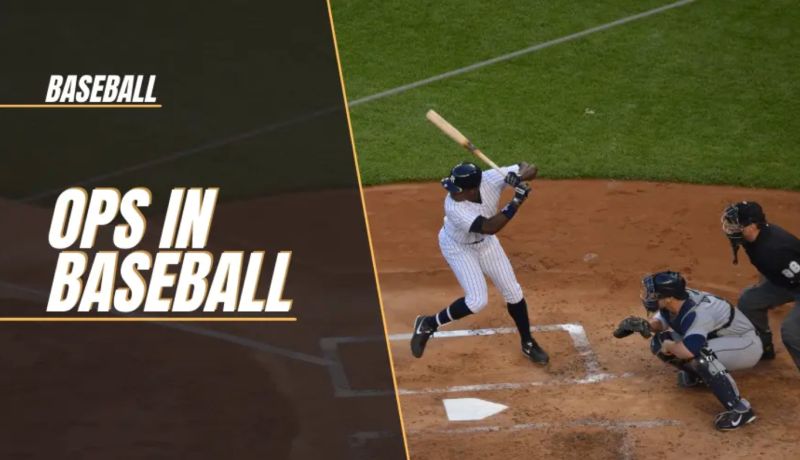There is no doubt that baseball is the ultimate sport for math nerds. OPS, for example, incorporates formulas from other statistics, which makes it very interesting. Calculating OPS, or on-base plus slugging, can be a quick way to gauge a player’s actual value to their team, even though it might seem like a complicated formula.
What is the formula for calculating OPS in baseball? Can you give me an example formula and an example number in baseball? Can you tell me about some of the best OPS seasons in baseball, as well as what OPS+ means?
A complete explanation of what OPS means in baseball can be found here.

Table of Contents
How is OPS Calculated in Baseball?
OPS is one of those statistics that depends on other statistics for its meaning. In order to calculate On-base plus slugging, we need two statistics:
- On-base percentage (OBP).
- The on-base percentage is a cold, hard statistic: how many times does a player reach base through any means? In OBP, it doesn’t matter how a player got on base. Did they get beaned? Did you walk? Did they hit a home run? All of it goes into their OBP.
- Slugging average (SLG).
- A player’s hit quality is evaluated using this rare formula. Similarly, a player’s batting average does not tell you what they hit, only that they scored hits at a certain rate. By using the number of bases achieved as part of the calculation, SLG incorporates the quality of those hits. In theory, a player could have a slugging average of 4.000, which means he would have a perfect ratio of home runs to at-bats. A player with a slugging average of 4.000 hits a home run in one at-bat. As an example, an SLG of 1.000 represents hitting a single in one at-bat.
Do Sacrifice Flies Count in OPS?
Exceptional circumstances, like sacrifice flies, do not affect either of these statistics because they don’t count toward at-bats. SLG is a measure of quality and rate, while OBP is a measure of rate. Combining on-base plus slugging gives a complete picture of a player’s hitting ability.
What is the formula for calculating it? Add the two together.
Example OPS Formula
Assume that a player has the following slash lines. The team has an on-base percentage of .385 and a slugging percentage of .435. To calculate OPS, add .385 + .435, which equals .820. An OPS of .820 would make that example player a good MLB hitter, but not an All-Star or MVP.
In the meantime, you have another player with the following slash lines. As a team, they have an on-base percentage of .475, as well as a slugging percentage of .505. Therefore, when you combine the two metrics, they have an OPS of .980, which would qualify them for an All-Star and MVP nomination.
What is a Good OPS in Baseball?
Major League Baseball fans sometimes find it difficult to understand how OPS works. How does it relate to plate appearances? What is the quality of the ballpark they’re hitting in during the season? How many bases have they scored?
Setting the measuring stick is the first step toward understanding what a good OPS is. The following are some of the best OPS in MLB history:
- Ruth, primarily of the New York Yankees, holds the all-time lead with an OPS of 1.1636.
- With a career average of around 1.0000, Mike Trout ranks among the all-time greats of the OPS.
- As of 2020, Barry Bonds is ranked 4th with an OPS of approximately 1.05
- The only other player with a 1.1+ OPS outside of Babe Ruth is Ted Williams of the Boston Red Sox. Among players with at least 3,000 at-bats.
That only gives us one end of the spectrum. How does the league average look? According to MLB’s statistics, the league average is around 0.700 to 0.800 in on-base plus slugging.
What is the Highest OPS in Baseball History?
The highest career OPS belongs to Babe Ruth of the New York Yankees. Over that many at-bats, his 1.1636 OPS may never be surpassed, making him possibly the greatest hitter of all time. However, that’s only one way to look at the metrics. It is also worthwhile to take a look at metrics like OPS season-by-season, which reveals how extraordinary some players’ careers have been.
- In 2004, Barry Bonds had a 1.4217 rating
- In 2002, Barry Bonds had a 1.3807 rating
- In 1920, Babe Ruth had a 1.3791 rating
- In 2001, Barry Bonds had a 1.3785 rating
- In 1921, Babe Ruth had a 1.3586 rating
- Ruth, Babe, 1923: 1.3089
The 7th-best season of OPS of all time belongs to Ted Williams. The fourth player on the list, Rogers Hornsby, appears only in the 13th spot.
What about High OPS Seasons in Recent Years?
- Bryce Harper had the highest OPS in 2021, with 1.044.
- The highest OPS in 2020 was 1.185 by Juan Soto. However, the number of games in the 2020 season was limited.
- As a result of Christian Yelich’s 1.1001 OPS in 2019, he ranked in the top 100 of all-time OPS seasons.
- With a 1.088 OPS, Mike Trout had the highest OPS in 2018.
Are there Better Stats than OPS?
There are those who would argue that adding up a hitter’s slugging percentage or slugging average with their on-base percentage is a crude measure of his talent. However, there may be more to it than you realize.
The OBP includes at-bats, walks, sacrifice flies, as well as pitches hit. Taking into account at-bats and total bases, the OPS statistic takes a lot into account. In addition to hits, walks, HBPs, and sacrifice flies, the overall formula also includes doubles and triples.
People like OPS because it correlates with how many runs a team has scored when calculated for an entire team. Because of this, many people view it as a great way to evaluate a hitter’s offensive performance.
What about OPS+?
Additionally, there is OPS+, which normalizes this statistic across leagues. A player’s OPS+ takes into account external factors such as the ballpark in which he was playing. An OPS of 100 represents the league average, which gives people an immediate sense of how a player’s offensive production compares to that of the entire league.
Thus, a Cubs player’s statistics might differ from a Dodger’s player’s, who might differ from a Cardinal’s player’s or a White Sox’s player’s. The “+” at the end of a player’s OPS seeks to level the playing field. The OPS+ of a player during free agency is significant because smaller ballparks are easier to hit home runs in.
Conclusion: What Does OPS Mean in Baseball?
The on-base average combined with the slugging percentage can provide insight into a player’s offensive performance. Like any other sabermetrics in baseball, it’s not always easy to measure everything without seeing it for yourself. To provide a more complete picture of a baseball player’s performance, consider using OPS in combination with additional metrics.
